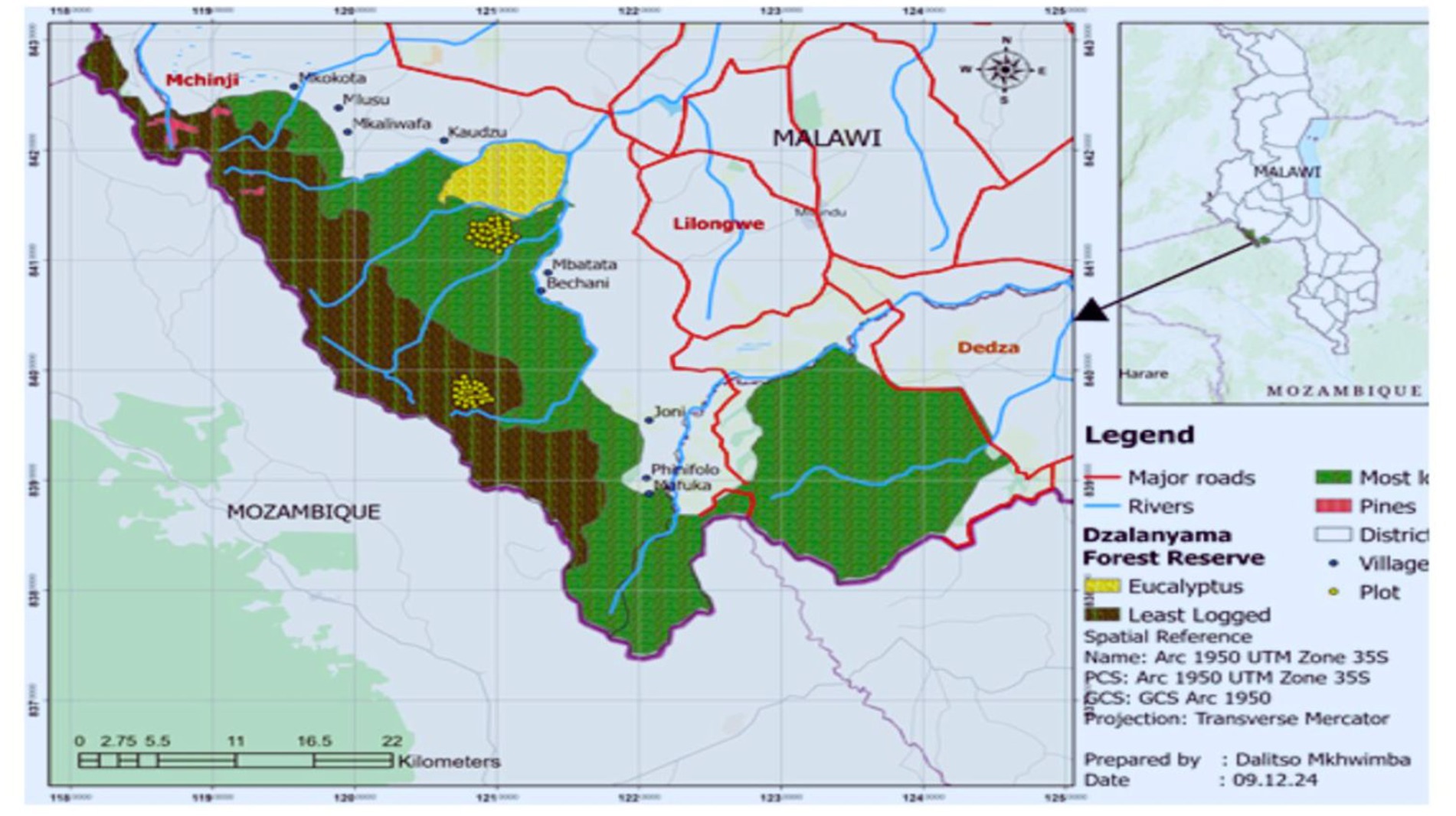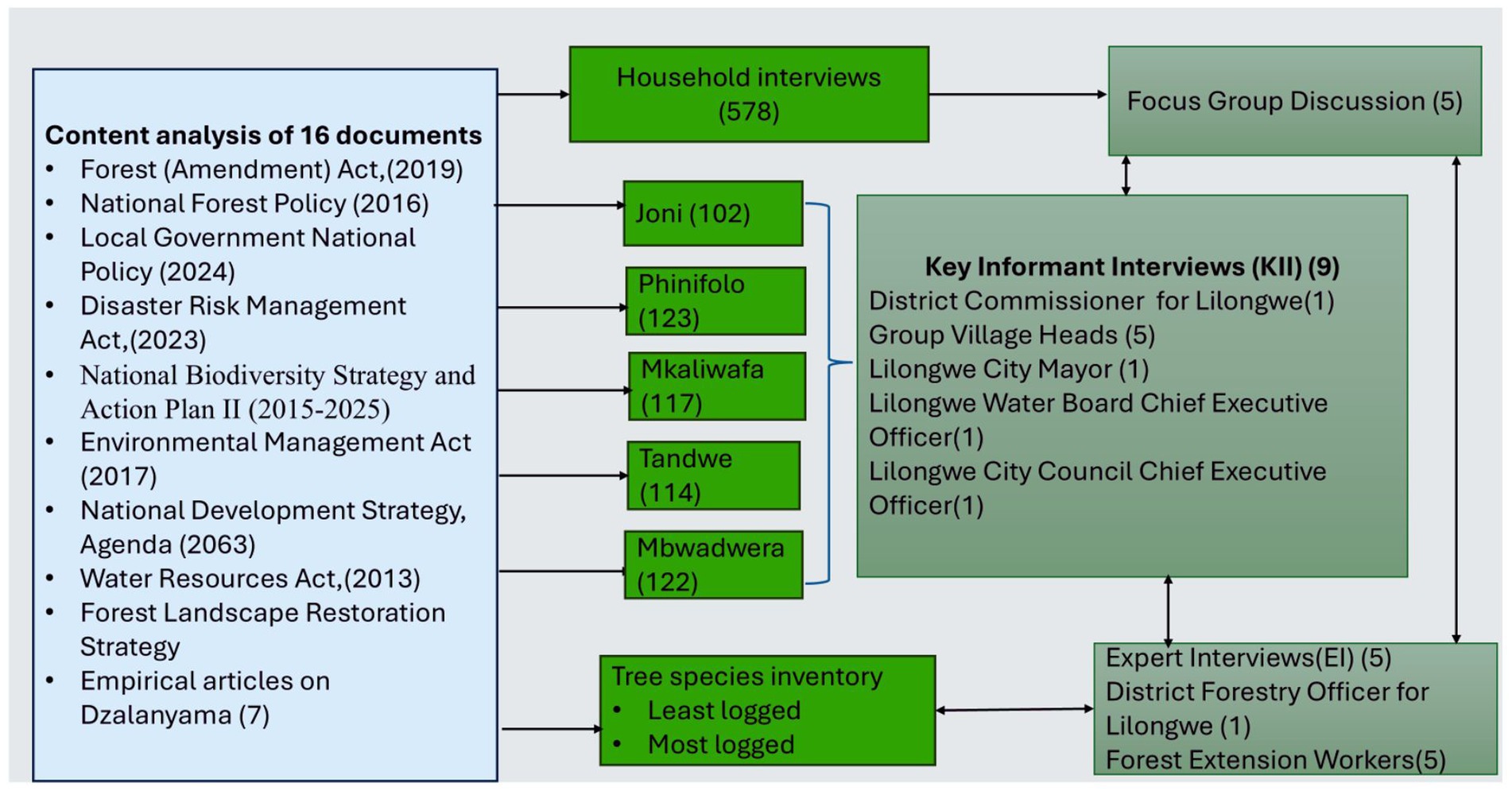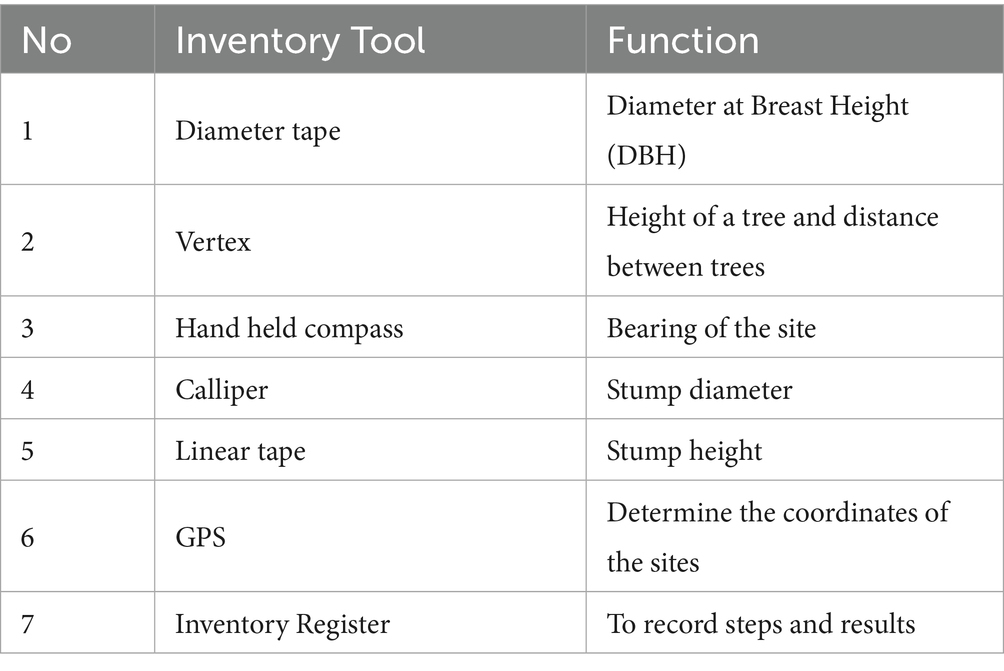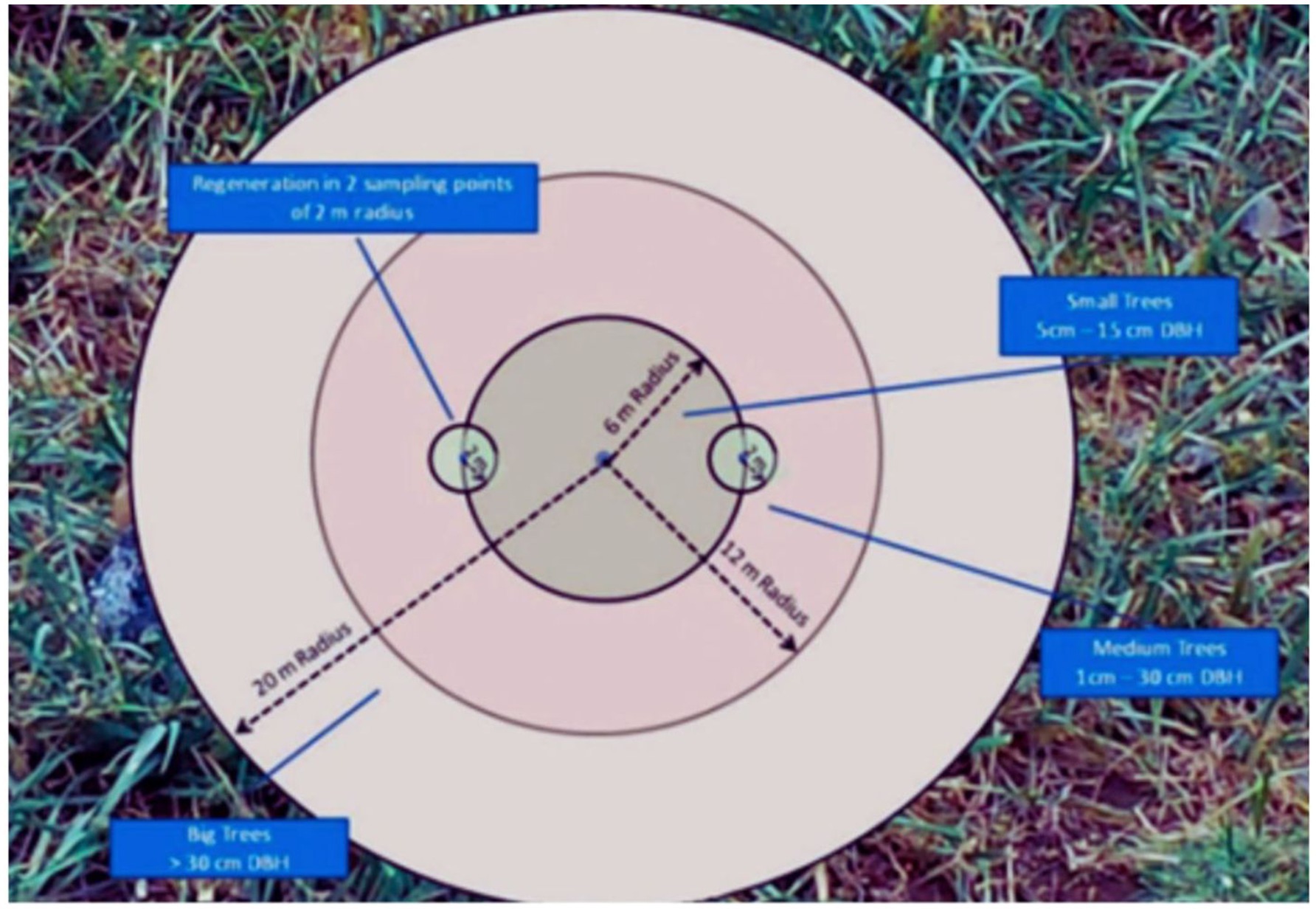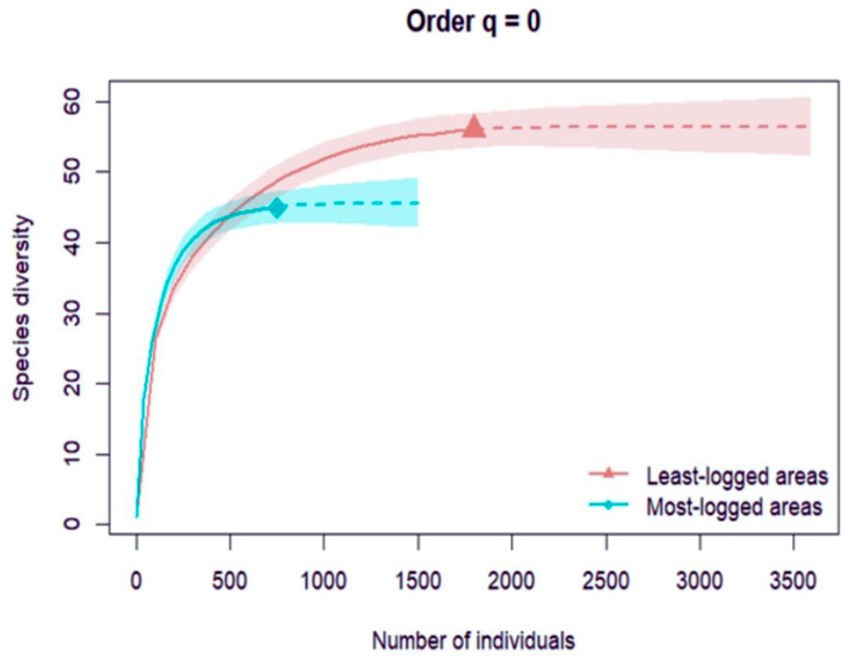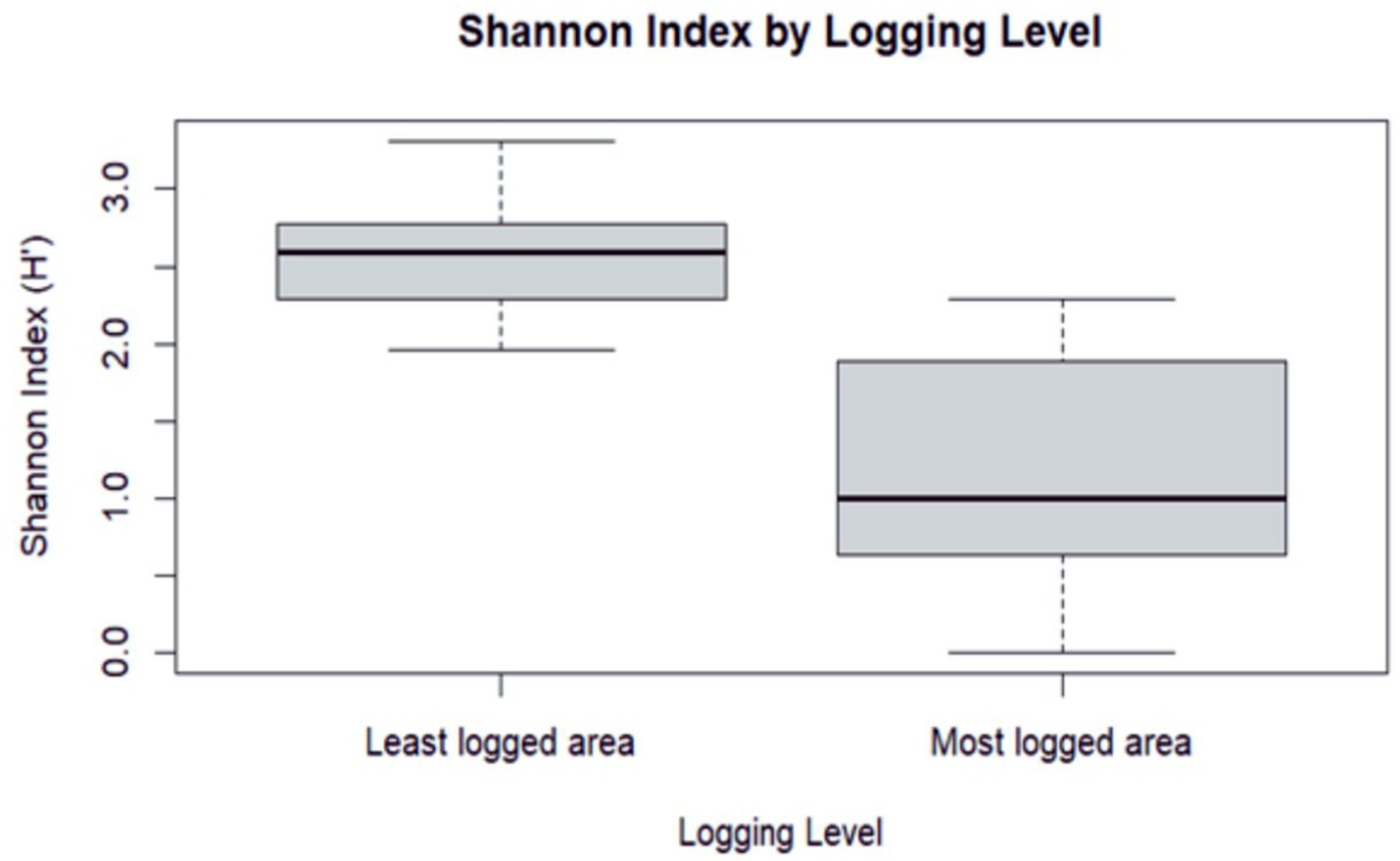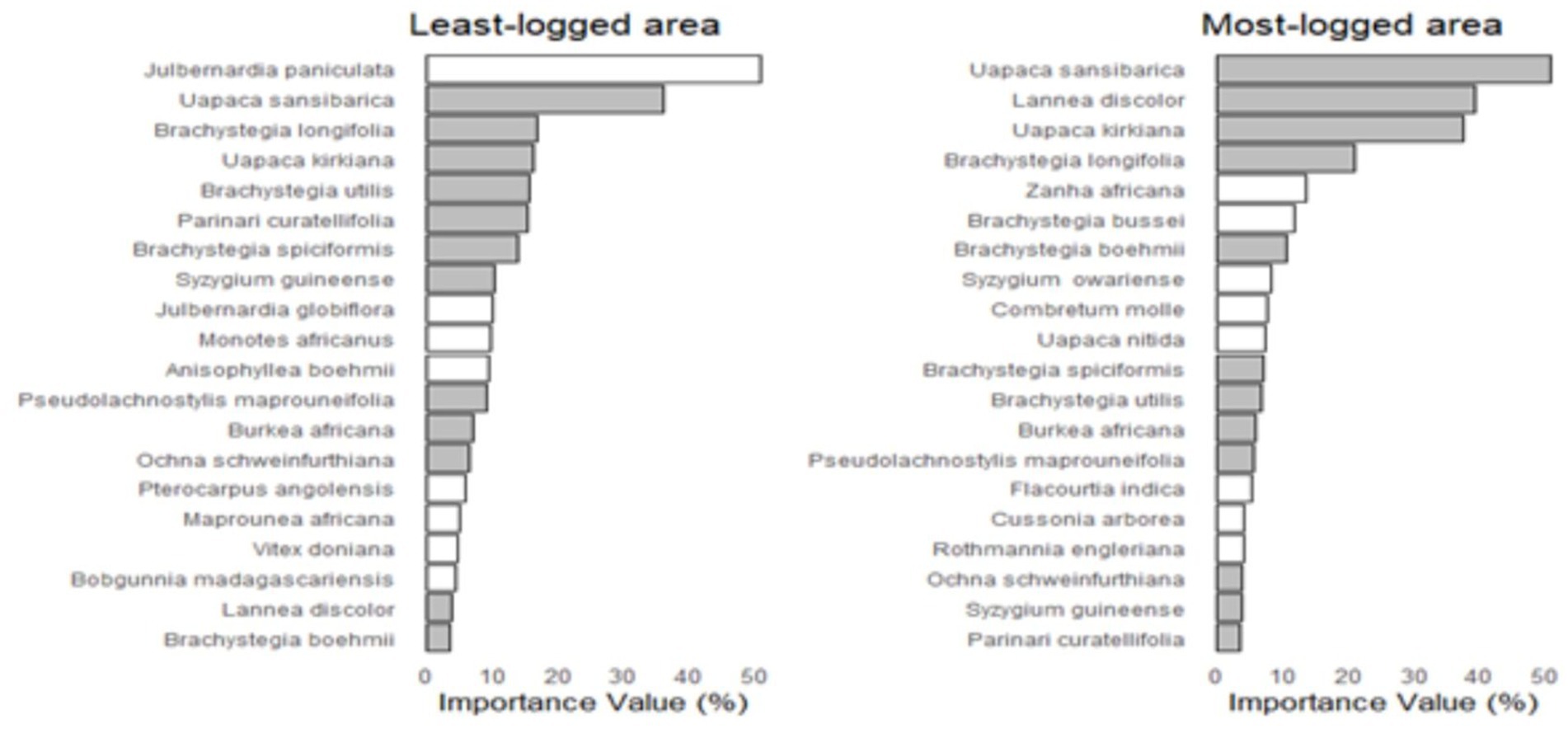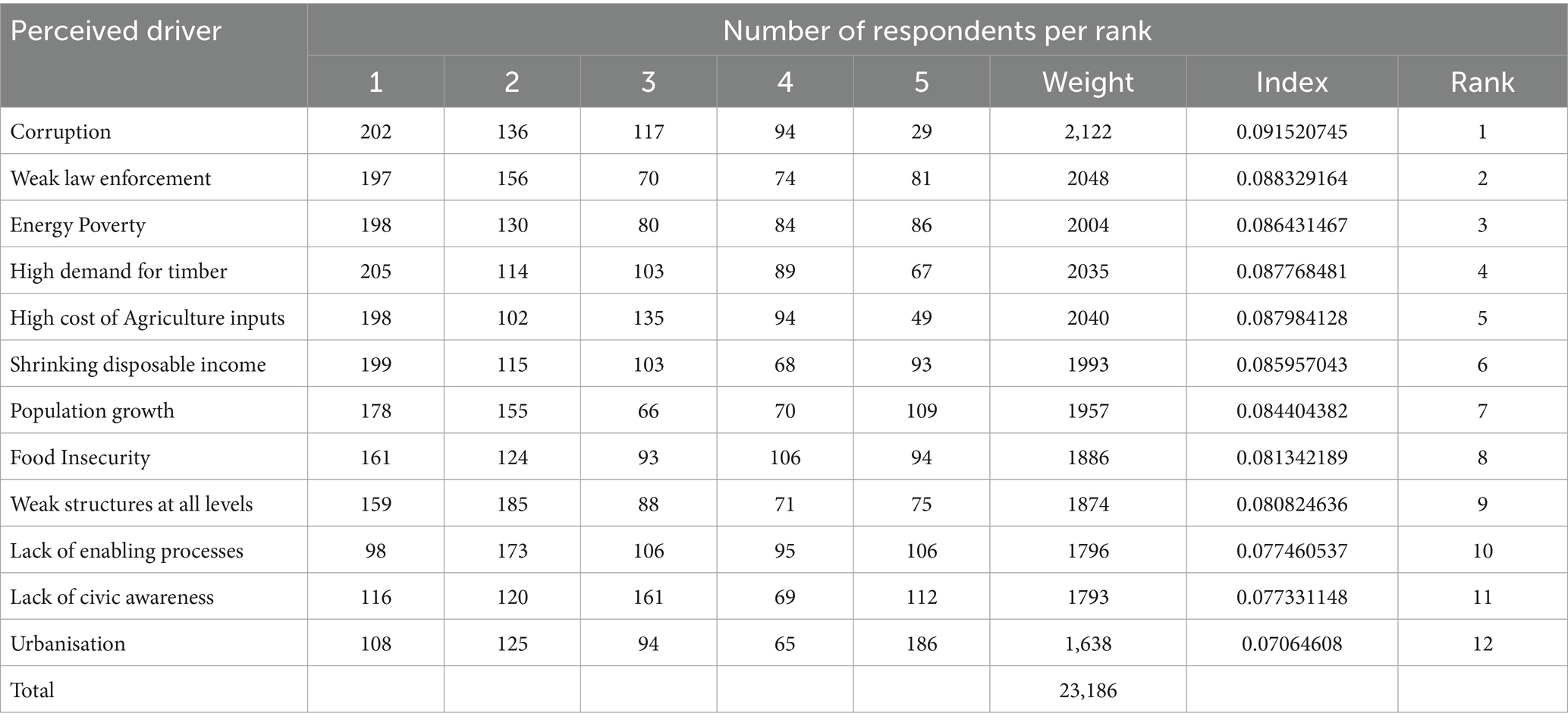- 1Technische Universität Dresden, Faculty of Environmental Sciences, Institute for International and Tropical Forestry, Dresden, Saxony, Germany
- 2United Nations University-Institute for Integrated Management of Material Fluxes and Of Resources, Dresden, Saxony, Germany
- 3Department of Forestry, Ministry of Natural Resources and Climate Change, Blantyre, Malawi
Logging in protected areas is widely acknowledged as a sustainability dilemma, as it sits at the centre of conservation and community livelihood goals. But is this position supported by scientific evidence? Our study used Dzalanyama Forest Reserve in Malawi as a case study to (1) examine the effects of logging on tree species diversity, (2) determine community perceptions on drivers of logging, and (3) explore the impact of logging on the water-energy-biota-soil (WEBS) nexus. To achieve this, we employed an explanatory sequential mixed methods approach. Our study showed that (a) extensive logging in protected forest areas reduces tree species diversity. We observed that the alpha (α) tree species diversity in the least logged and most logged areas did not differ significantly (p > 0.05). However, the beta (β) species diversity between the least and most logged sites differed significantly at a 95% confidence level, with Shannon indices of 2.55 and 1.15, respectively. (b) We reported corruption as the primary driver of logging, as perceived by local communities, with a weighted average index of 0.092, followed by weak law enforcement (0.088) and energy poverty (0.087). (c) Logging in protected areas significantly weakens the WEBS Nexus. We reported a positive correlation between tree species diversity and WEBS Nexus. These results suggest that extensive logging in Miombo woodlands reduces resource Nexus synergies while increasing trade-offs. Therefore, understanding the dynamics of forest resources triggered by logging in protected areas may inform policy direction and guide sustainable forest management planning.
1 Introduction
The Miombo woodlands of southern Africa are vital ecological zones characterized by their rich biodiversity and play a critical role in supporting local livelihoods. This unique ecoregion, which primarily consists of tree species of genera Brachystegia, Isoberlinia and Julbernardia, is not only essential for maintaining ecological balance but also underpins various socio-economic activities through forest products (e.g., timber and non-timber), and ecosystem services (Pascual et al., 2023). Miombo woodland is more pronounced in protected areas. According to the International Union for Conservation of Nature (International Union for Conservation of Nature, 2008), a protected area is a “clearly defined geographical space, recognised, dedicated and managed, through legal or other effective means, to achieve the long-term conservation of nature with associated ecosystem services and cultural values.” According to Wilkie et al. (2006), protected areas are environmentally sensitive tracts of land that are purposefully delineated, reserved, and protected from extensive external interference, including anthropogenic activities such as logging, hunting, and unprescribed fire. They are crucial in delivering essential ecosystem services such as climate regulation (Grey et al., 2016; Pascual et al., 2017; Pascual et al., 2023; Uprety et al., 2025; Martin et al., 2012), biodiversity conservation (e.g., pollination; O'Farrell et al., 2009), groundwater recharge (Reibeiro et al., 2015), soil erosion control (Chappa et al., 2024), and pollination (Martin et al., 2022). Despite their significance, there is ongoing concern about substantial deforestation within Protected Areas across the globe (Sheil, 1999; Wilkie et al., 2006; Mauambeta et al., 2010). One significant means of forest exploitation in protected areas is logging, which has detrimental implications for forest dynamics (White, 1993; Uprety et al., 2025). These disturbances play a crucial role in shaping forest conditions and the nexus of environmental resources. Logging significantly influences key processes in forest ecosystems by altering tree species diversity, nutrient and energy cycling, biomass accumulation, hydrological regimes, and other key ecosystem processes (Pascual et al., 2023). Such alterations affect forest dynamics by removing key tree species and disrupting ecological processes (Mponya et al., 2021). The forest’s ability to regenerate naturally is retarded, leading to shifts in species richness, loss of biodiversity, and weakened ecosystem function (Chidumayo, 2004; Uprety et al., 2025). Furthermore, the structural changes caused by logging, such as canopy gaps, exacerbate the challenges of forest recovery, making conservation efforts more complex (Chidumayo, 2004; Tobias, 2015).
As population growth and resource use dynamics evolve, the demand for forest resources intensifies, often compromising the integrity of protected ecosystems (Thorn et al., 2017). This alarming trend is exacerbated by community encroachment logging, which is frequently justified as a win-win resource benefit sharing but can have severe repercussions on biodiversity and ecosystem functions (Taylor and Lindenmayer, 2019). In the context of Dzalanyama, the challenge lies in balancing the need for sustainable resource utilisation by local communities with the imperative to maintain the ecological health of the forest reserve (Edwards et al., 2010). It has become evident that logging, even when regulation is purportedly in place, continues to disrupt wildlife habitats and diminish biodiversity values (Wong et al., 2024). Concern also arises from studies indicating that logging activities, particularly in miombo woodland, have lasting negative impacts on forest composition, structure, and ecosystem services (Montejo-Kovacevich et al., 2022). These impacts extend beyond the immediate area subjected to logging, influencing adjacent ecosystems and obstructing the natural processes vital for species recovery, habitat restoration and provision of diverse values of nature (Shchur et al., 2017; Pascual et al., 2023). Extensive logging within these woodlands poses severe threats to their ecological integrity and the broader resource nexus that connects human well-being to forest health. Logging activities driven largely by the demand for fuelwood and charcoal lead to significant deforestation and habitat degradation in the miombo woodlands. Research indicates that biomass removal, primarily linked to tree harvesting and land clearing for agriculture, results in substantial carbon emissions, contributing to climate change and biodiversity loss (Pelletier et al., 2018; Dewees et al., 2010). The degradation of these woodlands not only disrupts local ecosystems but also diminishes the availability of forest-derived resources essential for the survival and economic stability of rural communities (Oranu et al., 2022; Magalhães, 2025).
Moreover, the social dynamics surrounding illegal wood harvesting reveal that such practices commonly erode the abundance of valuable hardwood species, leading to a shift towards less commercially viable softwood types with long-term detrimental impacts on biodiversity (Muboko et al., 2019; Bruschi et al., 2014). The intricate relationship between local communities and these woodlands underscores the necessity for sustainable management practices. It is evident that while participatory forest management (PFM) initiatives have been implemented with the intent of resource conservation and improved livelihoods, they often fall short of achieving desired outcomes, highlighting the disconnect between policy intentions and ground realities (Senganimalunje et al., 2015; Munthali et al., 2018).
In particular, the Dzalanyama Forest Reserve in Malawi serves as a poignant case study, highlighting the multifaceted challenges arising from illegal logging practices and resource extraction, which compromise both conservation efforts and community livelihoods. Lessons from the Dzalanyama Forest Reserve underscore the urgent need for integrated management approaches that encompass both ecological conservation and socio-economic development. Understanding the root causes of deforestation and developing appropriate policies are critical to preserving the ecological functions of miombo woodlands while simultaneously supporting the livelihoods of communities that depend on them (Coutts et al., 2019; Muledi et al., 2016). As pressures from logging intensify, forthcoming research seeks to shed light on the interplay of ecological degradation and socio-economic vulnerability within these crucial habitats, advocating for strategies that harmonize human activities with ecological sustainability.
2 Analytical framework
The analytical framework of our study is anchored on a hybrid of the socio-ecological co-evolution framework (Figure 1) described by Berkes et al. (1998) and the Resource Nexus Framework by Brouwer et al. (2023). Such a hybrid framework is a practical and theoretical blueprint to elucidate the dynamics and nexus surrounding environmental resources, nature, and society (Pretzsch et al., 2014; Kimengsi et al., 2023; Brouwer et al., 2023). It allows for a distinction between human and ecological systems, incorporating citizen knowledge and scientific discoveries in theorising sustainability dilemmas in miombo woodland, particularly in protected areas like Dzalanyama forest reserve. Additionally, the framework illustrates the interactions between the conservation goals and the socio-economic goals triggered by forest resource use practices like logging (Berkes et al., 1998; Pretzsch et al., 2014; Kimengsi et al., 2023; Brouwer et al., 2023).
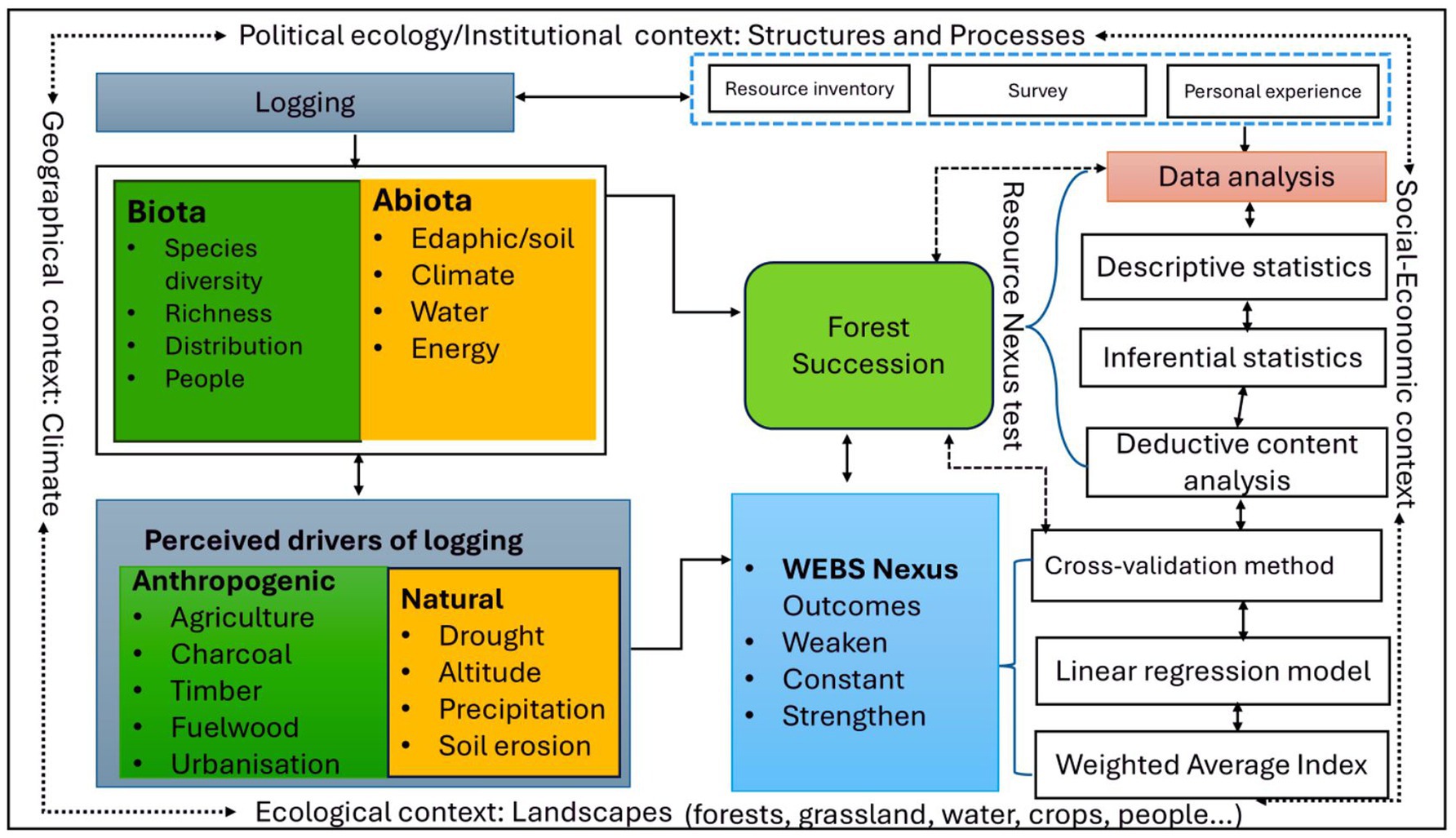
Figure 1. A hybrid analytical framework of the study adapted from Berkes et al. (1998), Kimmins (2000a, 2000b), and Brouwer et al. (2023). KEY: WEBS-Water-Energy-Biota-Soil.
The framework’s design reflects our understanding of the interactions among the social system (resource users), economic system, governance (the institutions that shape these systems), and the environmental system. This framework is justified for this study for several reasons. Firstly, forest resources, particularly in miombo landscapes (e.g., Dzalanyama Forest Reserve), are facing increasing pressure to meet the consumptive demands of population growth (e.g., Water, food, and energy), creating a serious sustainability dilemma. Therefore, resource use practices must strike a balance between environmental conservation and economic goals (Chappa et al., 2024). Secondly, climate change exacerbates human suffering worldwide (e.g., poverty, food insecurity, and extreme weather). Mitigation and adaptation to climate change must be understood at all levels of society (Ofremu et al., 2024) (Equations 1–8). Lastly, Resource Nexus outcomes driven by logging in protected areas require further exploration to inform policymakers about the future governance of forest resources.
The Dzalanyama Forest Reserve in Central Malawi serves as a significant case study, embodying the complexities of resource management within a biodiversity hotspot. Recent studies have underscored that while protected areas are essential for conserving biodiversity, they are increasingly threatened by illegal logging activities and changes in land use driven by local and global economic pressures (Brandt et al., 2015; Asefa et al., 2015; Chang and Turner, 2019; Birhane et al., 2020). Mponya et al. (2021) in Malawi explored the correlation between the extent of disturbances and tree species richness in forest reserves but did not explore the extent to which such disturbances could affect tree species diversity and Resource Nexus. Similarly, Munthali and Murayama (2011) assessed the logging activities of miombo woodlands in Malawi but did not theorise it in the context of the protected area. Furthermore, no study was conducted in Dzalanyama Forest Reserve to explore the impact of logging on the WEBS Nexus. As such, a noticeable research gap exists concerning the impact of logging on the reserve’s species diversity, the perceived drivers by local communities and the impact of logging on the nexus of environmental resources. In this research, we seek answers to the following questions: (1) How does logging influence tree species diversity? (2) How do communities perceive the drivers of logging in Dzalanyama? and (3) What is the impact of logging on the WEBS Nexus? Obtaining evidence-based answers to these questions is crucial for informing forest actors to advance nature-positive policies and interventions for sustainable forest management.
3 Methods and materials
3.1 Study area
The Dzalanyama Forest Reserve (Figure 2) is a protected area in Malawi that was gazette in 1922 as a forest reserve to protect biodiversity and provide watershed management for Lilongwe city. The reserve covers an area of 988 km2, that stretches across three districts: Lilongwe (619 km2), Dedza (356 km2), and Mchinji (14 km2). Dzalanyama Forest Reserve lies between latitudes 14.18° and 14.61° S and longitudes 33.35° and 33.92° E. Its elevation ranges from 1,100 to 1,650 meters above sea level, contributing to its subtropical highland climate. It is located on a range of hills known as the Dzalanyama Hills, which form the western border between Malawi and Mozambique (Munthali and Murayama, 2011).
The natural vegetation of Dzalanyama forest reserve is dominated by Miombo woodland, alongside two established plantations: Dzalanyama Timber Plantation (Pine: 18 km2) and Katete Plantation (Eucalyptus: 32 km2). This study focuses primarily on the Miombo Woodland, which covers most of the natural forest. Miombo woodland is a tropical forest in southern Africa with dominant tree species of genera Brachystegia, Julbernardia, and Isoberlinia (Chidumayo, 2004; Njoghomi et al., 2024). These tree species shed their leaves during the dry season. The open canopy allows sunlight to reach the ground, supporting the growth of grass and shrubs beneath. This creates a rich habitat for flora and fauna, serving as an essential resource for local communities.
3.2 Field measurements
Dzalanyama Forest Reserve was selected for this study because of its unique biodiversity characteristics, diverse natural values, and ongoing clandestine logging, especially for charcoal production and fuelwood. Its proximity to Malawi’s capital city, Lilongwe has increased the demand for charcoal and timber, resulting in forest degradation. The reserve also provides essential ecosystem services that are vital for the livelihoods of both rural and urban communities. As a protected area, the Dzalanyama forest reserve is a baseline for measuring changes in tree species diversity and its implications on the nexus of environmental resources and community livelihoods. We collected comparative data in the least-logged sites and most-logged sites to assess the impacts of logging. These sites were selected based on disturbance intensity for field measurement. This was achieved through consultations with locals who provided insights into the area’s history and current status. On-ground assessments complemented these consultations to ensure accuracy. The criteria used to assess disturbance levels included indicators of human activities, such as tree stumps, laps and tops and charcoal pits. Based on these insights, two sites were selected for detailed examinations; site one was assigned as the least logged, and site two as the most logged area.
The vegetation survey was conducted in 30 concentric plots: 15 plots in the most logged areas and the other 15 plots in the least logged areas. At each sampling plot, three concentric circular plots of radii 6 m (0.01 ha), 12 m (0.05 ha), and 20 m (0.13 ha) plus a regeneration plot of radius 2 m were laid out (Figure 3; Table 1).
To ensure accuracy and efficiency in data collection, two trained inventory teams were deployed, each consisting of four members: a team leader, a plant botanist, and a tree measurement specialist. The teams were equipped with the necessary tools. Each had a botanist from the National Herbarium and Botanical Gardens to help identify each tree and stump recorded in the field. This was necessary as each stump was identified to the species level based on characteristics such as bark texture and coppice shoots, ensuring accurate species identification. The teams systematically sampled the most and least disturbed areas of the Dzalanyama Forest Reserve. However, these concentric plots targeted different tree size classes: small trees (5–14.9 cm) dbh, medium trees (15–29.9 cm) dbh and big trees (>30 cm) dbh (Njoghomi et al., 2020). The inventory for this study was conducted in August 2024.
3.3 Survey data collection
A guided literature review was conducted where 16 documents, including seven empirical articles related to the Dzalanyama forest reserve, Forest (Amendment) Act, (2019), Environmental Management Act, (2017), the National Census Report (National Statistical Office of Malawi, 2019), Forest Inventory Report for Dzalanyama Forest Reserve and the National Biomass Energy Strategy were fully synthesized (Figure 4). The purpose of this guided literature review was to gain a deeper understanding of the history, context, and social relations of forest resource use practices in Dzalanyama forest reserve (Cleaver and de Koning, 2015; Kimengsi et al., 2022). This literature synthesis further guided the development of the research instruments, resulting in a checklist for focus group discussions and a questionnaire for interviews. Using the checklist, we conducted a total of five Focus Group Discussions (FGDs), one in each of the following villages: Joni, Phinifolo, Mkaliwafa, Tandwe and Mbwadwera, following the approach proposed by Finch et al. (2014). In each FGD, at least 12 participants were systematically selected and organised to fairly represent men, women, boys, girls and people with disabilities. They were asked open-ended questions to (1) discuss forest resource use practices in their area, (2) their relationship with Dzalanyama forest reserve, (3) forest governance issues, and the impact of logging in Dzalanyama on WEBS Nexus. This information informed the development of the questionnaire for the household survey and validated findings from the empirical analysis of our study. These were situational groups assembled by the researchers only for this study, with memberships composed of individuals linked to forest resource use practices in Dzalanyama. On average, FGDs lasted for about 45 min. Additionally, we conducted Key informant interviews to obtain experts’ perspectives on forest resource use practices and governance of the Dzalanyama forest reserve. The District Forestry Officer (DFO) for Lilongwe and five Forestry Extension Officers were interviewed as experts with the guidance of a checklist. We further interviewed 578 households to gather historical perspectives, their experiences, forest resource use practices and perceptions over drivers of logging in the Dzalanyama forest reserve (O'Farrell et al., 2009). Field data collection occurred between August 10 and October 30, 2024. Before data collection started, the English version of the research instruments was reviewed by peers and translated into the local language (Chichewa). The study was conducted in the villages adjacent to the Dzalanyama forest reserve, and their communities directly depend on the forest for their livelihoods. Therefore, the selected five villages presented the best case for this study. The interviews and FGDs were conducted in the Chichewa language to obtain better information on the study subject. However, our data collection team comprised Indigenous people who were comfortable to have conversations either in Chichewa, or English language. Although the researcher took notes, all interviews and discussions were recorded after obtaining the respondents’ verbal consent. The researchers brought forward issues during the focus group discussions and sought clarifications from the key informants. The respondents were informed that they could withdraw at any point during the interviews, should they feel uncomfortable with the exercise.
3.4 Statistical analyses
3.4.1 Tree species diversity
Tree species diversity means species abundance and distribution (Kimmins, 2004). The number of distinct species found in each plot was calculated to determine species abundance, while the evenness of the tree species was calculated to determine species distribution. We used the Dplyr package in R Software, which offers robust data manipulation and summary tools (Wickham et al., 2023). The number of distinct species in each group was calculated after the data was grouped by plot ID and Logging level. A summary of species abundance across different logging levels was calculated, including the mean, median, standard deviation, minimum, and maximum richness values. These descriptive statistics provided an overview of variability among logging levels and patterns of species richness. The non-parametric Wilcoxon Rank-Sum Test was used to determine the significance of the differences in species richness between sites with varying logging levels (Wilcoxon, 1945). This function is suitable for comparing distributions when the assumptions of parametric tests, such as normality, are not satisfied. We also used the iNEXT (Interpolation and Extrapolation) package (Chao et al., 2014) to calculate and visualise rarefaction and extrapolation sampling curves, specifically focusing on species richness and diversity within the Dzalanyama Forest Reserve (Kimmins, 2004). The iNEXT tool estimates diversity by considering both observed species (interpolation) and extrapolated diversity, offering insights into potential diversity levels that could be observed with additional sampling effort (Chao et al., 2014; Gotelli and Colwell, 2001). The iNEXT approach uses mathematical formulations to quantify species richness and diversity indices across varying sample sizes. For interpolation and extrapolation, the formula estimates richness based on observed data and provides an unbiased, minimum-variance estimate for smaller sampling sizes (Chao et al., 2014).
Where:
• = Observed species richness,
• = Total number of individuals in the sample,
• = Abundance of the species,
• = Sample size of the rarefied subset.
Extraction extends the rarefaction curve beyond the observed sample size using:
Where,
• = Estimated numb er of undetected species,
• = Number of singletons (species observed only once),
• = Additional sampling effort,
• = Total number of individuals in the original sample.
For this analysis, we specifically focused on species richness (q = 0), which represents the total number of species without considering their relative abundance (Chao et al., 2014). This measure is particularly suited for comparing biodiversity in the least and most disturbed areas, as it emphasizes raw species count. The rarefaction and extrapolation curves, plotted for q = 0, provide insights into how species richness responds to varying levels of sampling effort in each forest site, highlighting the potential biodiversity differences between these two disturbance levels.
To assess species diversity in both the least and most logged areas of Dzalanyama Forest Reserve (DFR), we calculated the Shannon-Wiener Diversity Index (H′; Shannon and Weaver, 1963; Kimmins, 2004) using species abundance data. The Shannon-Wiener Index is a widely used metric for species richness and evenness. This index is particularly useful in this study for comparing biodiversity across areas with different levels of disturbance, such as varying logging intensities. A vegan package was used to calculate the Shannon index for each plot (Oksanen et al., 2024). The diversity function from the package was employed to compute the negative logarithm of the proportion of individuals belonging to the species (H′).
The Shannon-Wiener Index (Shannon and Weaver, 1963) ′H′ is calculated using the following formula:
Where:
• = Total number of species.
• = Proportion of individuals belonging to species (i.e., relative abundance).
• = Base of the logarithm; natural logarithms (base e) are typically used.
Descriptive statistics were computed for the Shannon-Wiener Index at each logging level using the dplyr package (Shannon and Weaver, 1963; Kindt and Coe, 2005; Wickham et al., 2023; R Core Team, 2024) to examine the impact of logging on species diversity. This analysis facilitated a clear diversity comparison between the least-disturbed and most-disturbed areas. Subsequently, a Wilcoxon Rank-Sum Test (Wilcoxon, 1945) was conducted to determine whether significant differences in species diversity existed between the two logging levels.
3.4.2 Species composition
To assess the ecological importance of different species in both the least and most logged areas of Dzalanyama Forest Reserve (DFR), the Importance Value Index (IVI; Nguyen et al., 2014) was calculated. The IVI is a commonly used metric in forest ecology to determine the relative importance of species within a community by considering their abundance, dominance, and distribution. It is particularly useful for comparing species composition and structure between areas with varying levels of disturbance, such as different logging intensities. The IVI was calculated as a summation of the relative frequency, the relative density, and the relative dominance (Nguyen et al., 2014). It ranges between 0 and 300, with higher values indicating greater ecological importance within the community.
The IVI was calculated as the sum of three components: Relative Density, Relative Frequency, and Relative Dominance, each expressed as a percentage. The calculations were conducted using the Biodiversity R package (Kindt and Coe, 2005), which enables a robust analysis of species contributions to the overall ecosystem structure and composition. The following equations were used:
3.4.2.1 Relative density (RD)
= Total number of individuals of a species on a given logging level.
= Total number of all individuals of all species on a given logging level.
3.4.2.2 Relative frequency (RF)
= Frequency of a species on a given logging level.
= Total frequency of all species on a given logging level.
3.4.2.3 Relative dominance (RDo)
= Basal area of a species on a given logging level.
= Total basal area of all species on a given logging level.
The IVI is then calculated as:
3.4.3 Community perceptions
The ranking of community perceptions on the drivers of logging was done by the Principle of the Weighted Average Ranking Index. This was used in similar studies by Musa et al. (2006) in Sudan, Solomon et al. (2017) in Ethiopia and Munthali et al. (2018) in Malawi, and is computed as follows:
Where Rn = Value given for the least-ranked level (For example, the least ranked level of this study was 5). Rn-1 = 4, R1 = 1; Cn = the counts of the least ranked level (in the above example, the count of the 5th rank), and the count of the 1st rank = C1.
Data collected through FGDs and key informant interviews were qualitatively analysed using deductive content analysis (Creswell and Creswell, 2018; Kimengsi et al., 2022). A non-parametric test (Pearson’s chi-square) was used to determine the differences and associations between the selected socio-economic variables and community perceptions of the drivers of logging in the Dzalanyama Forest Reserve. Logistic regression analysis was performed to identify the most influential drivers (Equation 9). By determining the drivers of logging at the household level, the dependent variable was the community’s perception of the identified drivers. In contrast, independent variables included socio-economic characteristics, such as age, gender, family size, education, and land-holding size. Logistic analysis at the household level estimated the probability of the effects of the independent variables on the dependent variables (Musa et al., 2006; Solomon et al., 2017; Munthali et al., 2018):
Where 𝑌=dependent variable indicating the likelihood that 𝑌 = 1, 𝛼 = the intercept, 𝛽1 … 𝛽𝑛=coefficients of associated independent variables, and 𝑋1 … 𝑋𝑛 = independent variables.
3.4.4 Impact of logging on resource Nexus
To assess the impact of logging on Resource Nexus parameters (e.g., Water, Energy, Biota and Soil), we used ArcGIS Pro to determine the Normalised Difference Vegetation Index (NDVI) NDVI and Net Primary Production (NPP). This information was differentiated as dependent variables, while climatic, social, economic, and geographical parameters of Dzalanyama landscape were independent variables. The relationship between vegetation response and independent parameter indicators was initially explored using an Analysis of Variance (ANOVA) test to assess their significance. To further investigate potential interactions (Nexus) between variables, we conducted a multicollinearity examination among the variables. Multicollinearity refers to the extent to which independent variables correlate (Zarei et al., 2024). High multicollinearity can compromise regression model reliability by obscuring the effects of independent variables. Therefore, autocorrelation and multicollinearity assessments were performed to examine interactions and ensure the robustness of the model. These models utilised the Shannon index for both the most and least logged areas (e.g., NDVI and NPP). The aim was to assess vegetation dynamics indicators (NDVI, NPP) to the independent variable parameters. The performance and accuracy of the developed regression models were evaluated using cross-validation and validation indices. Cross-validation entails partitioning the data into subsets, training the model on some subsets, and validating it to ensure it performs well on unseen data. Validation indices, such as R-squared, mean squared error, and others, were used to quantify the model’s accuracy and predictive power (Zarei et al., 2024). Using multiple regression models with projected climate variables (e.g., Precipitation, Temperature and Evapotranspiration) as predictors, vegetation dynamics indicators (NPP, NDVI), water security, biodiversity and energy security indicators were estimated. By examining these variations, we can empirically trace areas where logging might most impact water, energy, biota, and soil dimensions in the resource nexus constellation.
4 Results
4.1 Effect of logging on tree species diversity
The study revealed a generally diverse array of tree species (2,545 trees) with diameters at breast height (DBH) greater than 5 cm. Of these trees, 1,798 were found in the least-logged areas, while 747 were recorded in the most logged areas. These trees represented 70 species overall, with 57 species identified in the least-disturbed areas and 46 in the most-logged areas. Species richness was highest in the least-logged areas and lowest in the most-logged areas. The Wilcoxon rank-sum test indicated a significant difference in species richness between the least-logged and most-logged areas (p < 0.05), where the species diversity increases as the number of species in the least logged areas increases. In most logged areas, species diversity increases more slowly (Figure 5). The curve reveals higher species diversity throughout the least-logged areas, reaching approximately 60 species, and consistently lower diversity at around 45 in the most-logged areas. The shaded regions around each curve represent confidence intervals, indicating minimal overlap between the two areas. This implies a statistically significant difference in richness between the two logging levels.
A total of 11,507 regenerants were recorded for the two logging levels. Among these, 8,278 were found in the most logged areas, while 3,229 regenerates were discovered in the least logged areas. These regenerants represented 101 species, with 57 species identified in the least logged areas and 77 in the most logged areas. This suggests that areas with higher levels of logging exhibit greater species richness than those with lower levels. Furthermore, the Wilcoxon rank-sum test also indicated a significant difference in species richness between the least and most logged areas, reinforcing this conclusion.
4.1.1 Key
Sample-size-based rarefaction (solid lines) and extrapolation (dashed lines) sampling curves in Figure 5, with 95% confidence intervals comparing species richness (q = 0) for the least and most logged areas.
The Shannon-Wiener diversity index (Figure 6) indicates that tree diversity is higher in areas that have been least logged than those that have been most logged. The least-logged areas exhibit a higher median index of approximately 2.5, with less variability, which reflects more extraordinary species richness and evenness. In contrast, the most logged areas have a lower median index of around 1.5 and more significant variability, suggesting reduced diversity and uneven species distribution due to the impacts of logging. Interestingly, most-logged areas reported higher diversity for regeneration than the least-logged areas. The average value of the Shannon diversity index (H′) was also significantly higher (p < 0.05) in the most-logged areas (2.14) compared to the least-logged areas (1.75).
Both the least-logged and most-logged areas shared several species, but disturbances such as logging led to the introduction and establishment of species adapted to these altered conditions. As a result, species composition in the studied forests has shifted due to disturbance. For instance, 33 species were common to both areas, while 24 species were exclusive to the least-disturbed areas, and 13 were unique to the most-disturbed regions. In the least-logged areas, Julbernardia paniculata was the most dominant species with an Importance Value Index (IVI) of 50.9, followed by Uapaca sansibarica (36.0), Brachystegia longifolia (16.8; Figure 7). In contrast, Uapaca sansibarica was the most dominant species in the most-logged sites with an IVI of 51.0, followed by Lannea discolor (39.3), and Uapaca kirkiana (37.5). Certain species like Dichrostachys cinerea, Dombeya rotundifolia, and Flacourtia indica were found exclusively in the most-logged areas. Conversely, important tree species such as Anisophyllea boehmii, Azanza garckeana, and Faurea rochetiana were only present in the least-logged areas.
A total of 79 species were recorded in the regeneration areas: 77 in the most-logged areas and 57 in the least-logged areas (Figure 6). Grey bars represent common species in both areas, and white bars represent unique species in each area. Of these, 52 species were common to both logging areas, 25 species were unique to the most-logged areas, and 5 species were found only in the least-logged areas. In the least-logged areas, the most dominant species was Julbernadia paniculata, with 758 counts, followed by Uapaca kirkiana, with 441 counts and Brachystegia spiciformis, with 278 counts. In the most-logged areas, Julbernadia paniculata was also the most dominant, with 1,405 counts, followed by Uapaca sansibarica with 827 counts and Lannea discolour with 578 counts. Certain species, such as Azanza gackeana, Combretum molle, and Magnistipula buteii, were found exclusively in the least-logged areas. In contrast, some species, like Anisophyllea formea, Annona senegalensis, and Brachystegia floribunda, were predominantly found in the most logged areas.
4.2 Community perceptions on the drivers of logging in Dzalanyama Forest Reserve
The socioeconomic and demographic attributes of the sampled households are presented in Table 2. The results revealed that the age of the respondents ranged from 18 to 95 years, with an average age of 41.3 years. About 91.5% of the respondents lived in the study area for more than a decade, and they had a better account of the logging activities in the Dzalanyama forest reserve. The majority (75.9%) of the respondents were married, at least 61.5% of the sampled households were female, and 73.1% were male-headed. The results also indicated that household size ranged from one person to 15 people, with an average of 6.2 persons. With respect to their education status, 79.3% of the respondents were literate, and 19.6% had never attended school. Approximately 88.5% of the sampled households were engaged in farming activities, and a small portion of the respondents (18%) were involved in non-farm activities, such as businesses, professional work, and craft work. The mean household income of the respondents was USD 471,36 (MK 826,951.92) per year. At least 91.3% of the respondents use charcoal or fuelwood for cooking and heating.
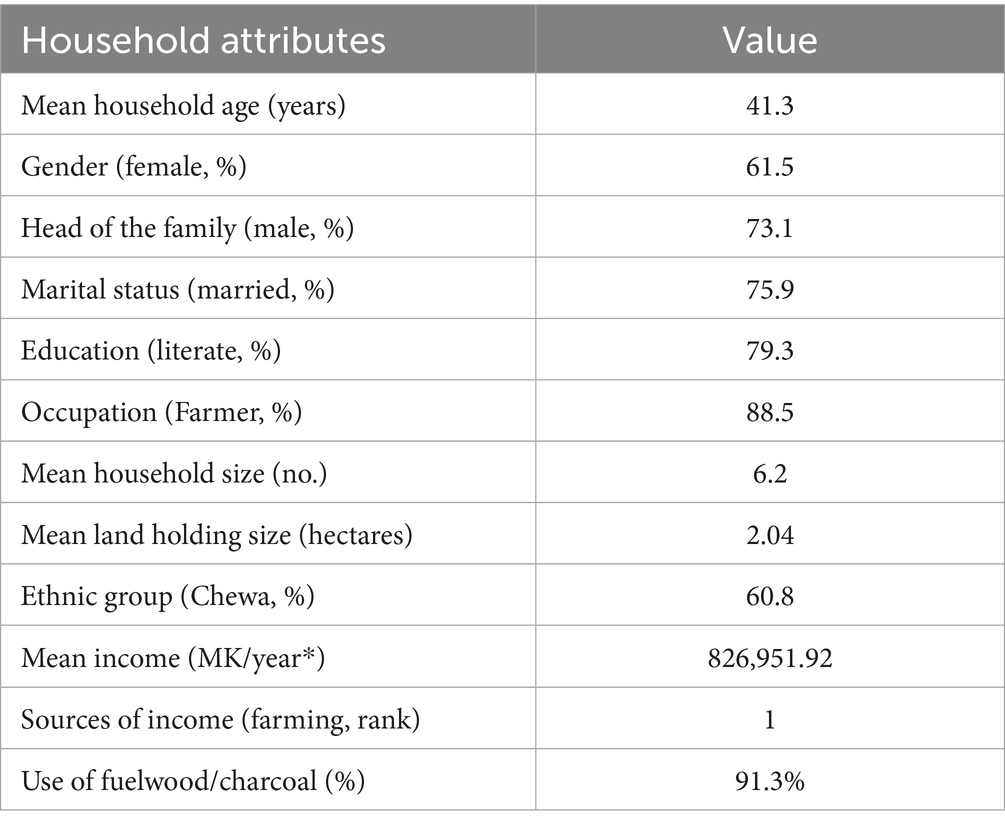
Table 2. Sampled household characteristics in the communities adjacent Dzalanyama Forest Reserve (N = 578).
We reported that corruption among the actors across Dzalanyama Forest reserve structures was perceived as the highest driver of logging (Table 3), with a weighted Average index of 0.09152, followed by Weak law enforcement (0.08838) and Energy poverty (0.08798). Nevertheless, the local communities perceive urbanisation as the least driver to logging in Dzalanyama with an index value of 0.07064, followed by lack of civic education (0.7733) and lack of enabling processes (0.07734).
The descriptive statistics results revealed that the respondents’ education level, religion, and age significantly affected (p < 0.05) the perceptions of local communities regarding the drivers of logging in the Dzalanyama forest reserve (Table 4). On the other hand, gender and marital status (p > 0.05) did not have a significant influence on the respondents’ perception towards drivers of logging in Dzalanyama forest reserve.
4.3 Effects of logging on water-energy-biota-soil Nexus
We report that logging in protected areas either strengthens or weakens the Resource Nexus, and in rare exceptions, the status of the environmental resources remains unaffected. The strong positive correlations were reported between NDVI and NPP/ET/T (r = 0.95, p < 0.001) for all independent variables. This suggests that the least logged areas with higher vegetation health demonstrate greater productivity, higher evapotranspiration rates and relatively higher temperatures (Zarei et al., 2024). Furthermore, the partial correlation analysis, which accounted for precipitation, temperature, and ET0, revealed a statistically significant and relatively strong positive correlation between NDVI and NPP, with a correlation coefficient of 0.71 (p < 0.001). This result indicates a significant correlation between the vegetation index and primary productivity, even after controlling for various environmental factors. Specifically, an increase in vegetation health and density is moderately associated with increases in primary productivity. We also observed multicollinearity below 0.5 among all the predictors for both NDVI and NPP. According to Zarei et al. (2024), any value below the commonly cited threshold of 0.5 suggests some degree of correlation among the predictor variables, but it is not severe enough to cause significant issues with the regression analysis. The prediction model’s performance indicated good and acceptable results, confirming that variations in Dzalanyama forest biotic and abiotic parameters contain reasonable explanatory power in explaining changes in Dzalanyama. The least logged Sites show low temperatures and high precipitation. Secondly, most logged areas experience high temperatures and evapotranspiration, resulting in significant water loss from the trees. The third finding highlights that areas with high precipitation and evapotranspiration have a significant impact on soil moisture and the health of vegetation. By analysing these results, actors can understand how species diversity in protected areas interacts with other environmental resources. Energy use in Malawi is primarily driven by biomass, predominantly wood and charcoal, accounting for at least 86% of overall energy use and up to 99% for household use (Government of Malawi, 2023). Although Hydroelectricity is Malawi’s largest electricity generation source, providing up to 90% of the total electricity, its access is limited to urban areas and industries. This means logging transforms protected areas from high biodiversity of flora to reduced terrestrial biodiversity, but also increases surface run-off and soil erosion. Such alterations render the soil unproductive for crop production, particularly cereals (e.g., Maize), the staple food of Malawi. Furthermore, soil erosion may lead to the siltation of important rivers for electricity generation, such as the Shire, which hosts several major hydroelectric power stations. The siltation of rivers may also cause water pollution and reduce aquatic biodiversity (e.g., Fish). The fishing industry is a crucial food and economic resource in Malawi, particularly among local communities (Simmance et al., 2021). Based on the technological analysis of such interactions and results from focus group discussions and ethnography, we estimated that logging has significant trade-offs among environmental resources (e.g., water, energy, biota, and soil). This information is essential for sustainable development planning, biodiversity conservation and climate resilience.
5 Discussion
5.1 Effects of logging on tree species diversity
In this study, 2,545 trees with a diameter at breast height (DBH) greater than 5 cm were recorded, revealing a notable discrepancy between the least logged and most logged areas. Specifically, 1,798 trees were found in the least-logged areas, whereas only 747 were identified in the most-logged zones. These trees represented 70 species, with 57 species identified in the least-logged regions and 46 in the heavily logged areas. The results indicated significantly higher species richness in minimally disturbed areas compared to heavily logged sections, as confirmed by a Wilcoxon rank-sum test (p < 0.05; Yamashina et al., 2020: Sheil, 1999; Tobias, 2015). This trend corroborates findings from similar studies, indicating that logging activities diminish biodiversity within miombo woodlands (Gonçalves et al., 2017; Koller and Samimi, 2011; Pascual et al., 2023; Santos et al., 2024).
The species diversity curve in our study demonstrates this divergence, highlighting that the least-logged areas consistently sustain higher species diversity (Martin et al., 2022). This supports the hypothesis that logging has a negative influence on ecological diversity, as the least-disturbed areas displayed an average of 60 species (Putz et al., 2012). In contrast, the most-logged regions had approximately 45 species (Loft et al., 2024). Furthermore, 11,507 regenerants were documented, with 8,278 located in areas with heavy logging. A diverse assemblage of 101 species was identified among these regenerants, challenging conventional notions that high logging intensity universally correlates with lower species richness. Notably, while the least-disturbed areas preserved 57 regenerating species, the most-disturbed regions exhibited a surprising increase to 77 species. This observation is contextualised by the introduction of species that are better adapted to post-disturbance environments (Chidumayo, 2013).
Additionally, the Shannon-Wiener diversity index demonstrated the pronounced difference in tree diversity across logging levels; the least-logged areas exhibited a median index of approximately 2.5, characterised by more excellent uniformity and richness, contrasting sharply with the 1.5 index in the most-logged areas, which experienced more significant variability, indicative of a disrupted ecosystem (Mwakalukwa et al., 2014). The assessment also revealed 33 species common to both logging levels, while 24 species were exclusive to the least-disturbed areas and 13 unique to the most-logged, further illustrating how anthropogenic disturbances alter species composition within these forest ecosystems (Gonçalves et al., 2017).
5.2 Community perceptions on the drivers of logging in Dzalanyama Forest Reserve
The socio-economic and demographic characteristics of the 578 sampled households revealed critical insights into community perceptions regarding logging activities. The age of respondents ranged from 18 to 95 years, with an average of 41.3 years. A significant majority (91.5%) had lived in proximity to the Dzalanyama Forest Reserve for over a decade, providing them with substantial contextual knowledge of logging impacts. Most respondents (75.9%) were married, and the gender distribution leaned heavily towards male-headed households (73.1%). Approximately 88.5% of this population engaged primarily in farming, representing a community dependent on the natural resources provided by the forest (Wallenfang et al., 2015; Rono et al., 2019).
Community perceptions identified corruption as the foremost driver of logging, followed closely by weak law enforcement and energy poverty. Interestingly, urbanisation was ranked as the least significant driver. Statistical analysis revealed that variables such as education level and religion had a substantial effect on perceptions of logging drivers, while factors like gender and marital status did not show a significant influence (Reibeiro et al., 2015). This aligns with previous research indicating that local socio-economic dynamics help shape user perceptions and their relationship with natural resource exploitation in miombo ecosystems (Malunga et al., 2021; Kamusoko et al., 2014).
5.3 Effects of logging on the water-energy-biota-soil Nexus
Our analysis reveals that logging within protected areas significantly impacts the Resource Nexus, which comprises the interconnected biotic and abiotic components of ecosystems. A robust positive correlation was observed between the Normalised Difference Vegetation Index (NDVI) and Net Primary Productivity/Evapotranspiration/Temperature (NPP/ET/T), where the least-logged areas exhibited higher indices, signifying healthier vegetation and greater productivity levels (r = 0.95, p < 0.001; Loft et al., 2024; Manyanda et al., 2020). These findings prompt vital discussions about the repercussions of logging on local microclimates and the consequent impact on agricultural productivity, which heavily relies on these forest ecosystems (Pascual et al., 2023; Santos et al., 2024).
The implications extend to alterations in soil moisture and vegetation health resulting from varying rates of evapotranspiration due to logging intensity (Pascual et al., 2023). Notably, increased logging typically results in elevated temperatures, leading to irreversible ecological changes, such as water scarcity and increased soil erosion, which negatively impact crop productivity, particularly that of staple crops like maize (Chappa et al., 2024). Consequently, logging activities not only threaten terrestrial biodiversity but also exacerbate resource shortages and diminish the overall ecological functionality essential for local livelihoods (Mwakalukwa et al., 2014; Puspita and Wisanti, 2023).
Considering that this study only focused on the Dzalanyama forest reserve in central Malawi, it is important to note that the ecological complexity of Miombo woodlands poses a challenge for generalisation. Variability in species composition, soil health, and biomass dynamics is highly context-specific. Studies have demonstrated that Miombo ecosystems can regenerate under certain conditions, complicating assessments of logging impacts. For instance, Jew et al. (2016) observe the resilience of some species despite deforestation, suggesting that degradation may not be uniform across all areas (Manyanda et al., 2021). Thus, a limitation of the study could be the overemphasis on degradation without adequately accounting for areas with robust recovery potential or varying ecological responses to logging (Nghonda et al., 2024).
Moreover, anthropogenic influences extend beyond logging; pressures from agriculture, shifting cultivation, and fire regimes interact and compound the impacts on biodiversity and carbon stocks (Manyanda et al., 2021). Frequent fires can lead to significant alterations in woodland structure, potentially overshadowing the impacts of logging if not adequately controlled and studied in tandem (Kimmins, 2000a, 2000b; Chidumayo, 2004; Manyanda et al., 2020). This suggests that the findings from this study may not adequately distinguish the effects of logging from other environmental and anthropogenic drivers, potentially leading to skewed conclusions regarding the relationship between logging practices and ecosystem health.
Our methodological approach, including sample size and the selection of inventory plots, was guided by the local communities and entirely depended on visual assessments to distinguish the least-logged and Most logged areas. Such an approach can lead to insufficient data on species interactions and ecosystem services, undermining the study’s conclusions about the diverse values of nature (Bulenga et al., 2023). Comprehensive assessments would require a more systematic approach to data collection that accommodates the heterogeneity of the woodland ecosystems.
However, our study highlights substantial trade-offs among environmental resources resulting from logging in the Dzalanyama Forest Reserve, underscoring the urgent need for sustainable resource management approaches that balance human needs with ecological health (Chappa et al., 2024). Effective conservation strategies must incorporate community insights to mitigate the adverse impacts of logging and ensure the integrity of the Water-Energy-Biota-Soil Nexus.
6 Conclusion
The findings from this study highlight the profound impact of logging activities on tree species diversity and community relationships within forest ecosystems in the Dzalanyama Forest Reserve. Our assessment revealed significant discrepancies in species richness and biodiversity between least-logged and most-logged areas, confirming that increased logging leads to reduced species diversity and altered forest composition. The estimated 70 species present in the forest indicate a healthy diversity. However, this richness was notably diminished in heavily logged regions, providing clear evidence of the adverse ecological consequences of logging practices.
Moreover, the community perception analysis highlighted the socio-economic drivers of logging, identifying corruption, weak law enforcement, and energy poverty as primary contributors to unsustainable logging practices. This reflects a complex interplay between local socio-economic conditions and forestry management, where the livelihoods of surrounding communities are heavily reliant on forest resources. The significant correlation between socio-economic factors and perception indicates that continuous engagement with local communities is crucial for fostering sustainable practices and protecting biodiversity.
Additionally, evaluating the water-energy-biota-soil nexus elucidated the intricate interdependencies between ecosystem health and community well-being. The analysis demonstrated that logging threatens biodiversity and exacerbates significant challenges such as soil erosion, surface runoff, and water scarcity, which are pivotal to agricultural productivity and local food security. The strong correlations between vegetation health (NDVI) and primary productivity in least-logged areas further affirm the critical role of intact ecosystems in maintaining ecological balance and supporting human activities.
In light of these results, this study emphasises the urgent need for sustainable forest management strategies that incorporate community perspectives and prioritise biodiversity conservation. Policy interventions should focus on combating corruption, strengthening law enforcement, and addressing energy poverty. Promoting participatory forest management can empower local communities to engage in forest conservation actively, thus reconciling ecological integrity with socio-economic well-being. We recommend that forest actors, including policymakers in Malawi, craft a public policy based on the findings of this study. They should especially develop and revamp processes (e.g., policies and strategies) and structures to effectively reduce illegal logging, corruption, empower actors and promote community surveillance in forest use practices such as payment for ecosystem services and community-based carbon trade initiatives to reduce dependence on logging. In conclusion, the case of Dzalanyama Forest Reserve serves as a critical reminder of the intricate balance required for effective resource management. Sustainable practices that respect both the ecological value of these miombo woodlands and the livelihoods of local communities are essential for preserving this unique ecosystem for future generations. To ensure a viable future, stakeholders must align conservation efforts with forest-dependent communities’ socio-economic realities, fostering a more holistic approach to managing Malawi’s natural resources.
Data availability statement
The raw data supporting the conclusions of this article will be made available by the authors, without undue reservation.
Author contributions
YM: Conceptualization, Formal analysis, Investigation, Methodology, Project administration, Supervision, Validation, Visualization, Writing – original draft, Writing – review & editing. DM: Data curation, Formal analysis, Investigation, Methodology, Software, Writing – original draft, Writing – review & editing.
Funding
The author(s) declare that financial support was received for the research and/or publication of this article. This study was supported by the German Academic Exchange Service (DAAD). We thank Technische Universität Dresden, through the Faculty of Environmental Sciences, for covering the Article Processing Costs (APC). Special thanks to DAAD-EPOS for providing scholarships to both authors to study in Germany.
Conflict of interest
The authors declare that the research was conducted in the absence of any commercial or financial relationships that could be construed as a potential conflict of interest.
Generative AI statement
The author(s) declare that no Gen AI was used in the creation of this manuscript.
Publisher’s note
All claims expressed in this article are solely those of the authors and do not necessarily represent those of their affiliated organizations, or those of the publisher, the editors and the reviewers. Any product that may be evaluated in this article, or claim that may be made by its manufacturer, is not guaranteed or endorsed by the publisher.
References
Asefa, A., Shimelis, A., and Kinahan, A. (2015). Assessment of threat status in the northern woodlands of the Bale Mountains, Ethiopia: indicator for management effectiveness. Ethiop. J. Environ. Stud. Manag. 8:318. doi: 10.4314/ejesm.v8i3.9
Berkes, F., Folke, C., and Colding, J. (1998). Linking social and ecological systems: management practices and social mechanisms for building resilience : Cambridge University Press.
Birhane, E., Fekensa, Z., Tewolde-Berhan, S., Rannestad, M. M., and Solomon, N. (2020). The diversity and distribution of lianas under various disturbance regimes in Chilimo dry Afromontane forest, Ethiopia. Glob. Ecol. Conserv. 23:e01045. doi: 10.1016/j.gecco.2020.e01045
Brandt, J., Butsic, V., Schwab, B., Kuemmerle, T., and Radeloff, V. (2015). The relative effectiveness of protected areas, a logging ban, and sacred areas for old-growth forest protection in Southwest China. Biol. Conserv. 181, 1–8. doi: 10.1016/j.biocon.2014.09.043
Brouwer, R., Brander, L., Kuik, O., Papyrakis, E., and Bateman, I. (2023). The economic value of wetland ecosystem services: A meta-analysis. Environmental and Resource Economics, 84, 1–30. doi: 10.1007/s10640-022-00730-w
Bruschi, P., Mancini, M., Mattioli, E., Morganti, M., and Signorini, M. (2014). Traditional uses of plants in a rural community of Mozambique and possible links with miombo degradation and harvesting sustainability. J. Ethnobiol. Ethnomed. 10:59. doi: 10.1186/1746-4269-10-59
Bulenga, G., Maliondo, S., Katani, J., and Nyberg, G. (2023). Tree species diversity and edaphic factors associated with different land uses in tropical forest ecosystems, Tanzania. Open J. Ecol. 13, 759–772. doi: 10.4236/oje.2023.1310046
Chang, C. C., and Turner, B. L. (2019). Ecological succession in a changing world. J. Ecol. 107, 503–509. doi: 10.1111/1365-2745.13132
Chao, A., Gotelli, N. J., Hsieh, T. C., Sander, E. L., Ma, K. H., Colwell, R. K., et al. (2014). Rarefaction and extrapolation with hill numbers: a framework for sampling and estimation in species diversity studies. Ecol. Monogr. 84, 45–67. doi: 10.1890/13-0133.1
Chappa, S., Mwase, J., and Nyirenda, V. (2024). Community-based forest management in Africa: Lessons from participatory approaches. Springer Nature.
Chappa, L. R., Nungula, E. Z., Makwinja, Y. H., Ranjan, S., Sow, S., Alnemari, A. M., et al. (2024). Outlooks on major agroforestry systems. Sustainable Agroforestry Practices: Global Perspectives. ed. R Kumar. (Wiley Online Library), 21–48.
Chidumayo, E. N. (2004). Development of Brachystegia-julbernadia woodland after clear felling in Central Zambia: Evidence for high resilience. Opulus Press: Sweden.
Chidumayo, E. (2013). Estimating tree biomass and changes in root biomass following clear-cutting of brachystegia-julbernardia (miombo) woodland in Central Zambia. Environ. Conserv. 41, 54–63. doi: 10.1017/s0376892913000210
Cleaver, F., and de Koning, J. (2015). Furthering critical institutionalism. Int. J. Commons 9, 1–18. doi: 10.18352/ijc.605
Coutts, C., Holmes, T., and Jackson, A. (2019). Forestry policy, conservation activities, and ecosystem services in the remote Misuku hills of Malawi. Forests 10:1056. doi: 10.3390/f10121056
Creswell, J. W., and Creswell, J. D. (2018). Research design: Qualitative, quantitative and mixed methods approaches. 5th Edn. SAGE Publications.
Dewees, P., Campbell, B., Katerere, Y., Sitoe, A., Cunningham, A., Angelsen, A., et al. (2010). Managing the Miombo woodlands of southern Africa: policies, incentives and options for the rural poor. J. Nat. Resour. Policy Res. 2, 57–73. doi: 10.1080/19390450903350846
Edwards, D., Hodgson, J., Hamer, K., Mitchell, S., Ahmad, A., Cornell, S., et al. (2010). Wildlife-friendly oil palm plantations fail to protect biodiversity effectively. Conserv. Lett. 3, 236–242. doi: 10.1111/j.1755-263X.2010.00107.x
Finch, H., Lewis, J., and Turley, C. (2014). “Focus group” in Qualitative research practice: A guide for social science. eds. J. Ritchie, C. Mc Naughton Nicholls, and R. Ormston. 2nded ed (Sage, Los Angeles, California, USA: Students and Researchers), 211–242.
Gonçalves, F., Revermann, R., Gomes, A., Aidar, M., Finckh, M., and Juergens, N. (2017). Tree species diversity and composition of miombo woodlands in south-Central Angola: a chronosequence of forest recovery after shifting cultivation. Int. J. Forest. Res. 2017, 1–13. doi: 10.1155/2017/6202093
Gotelli, N. J., and Colwell, R. K. (2001). Quantifying biodiversity: procedures and pitfalls in the measurement and comparison of species richness. Ecol. Lett. 4, 379–391. doi: 10.1046/j.1461-0248.2001.00230.x
Government of Malawi (2023). The digest of Malawi energy statistics. Lilongwe, Malawi: Ministry of Energy.
Grey, E. K., Bernhardt, J. R., and Li, G. (2016). Effects of land use and disturbance on stream insect richness and functional diversity. Ecosphere 7:e01578. doi: 10.1002/ecs2.1578
International Union for Conservation of Nature (2008). Defining protected areas: An international conference in Almeria, Spain. Gland, Switzerland: IUCN.
Jew, E. K., Dougill, A. J., Sallu, S. M., O’Connell, J., and Benton, T. G. (2016). Miombo woodland under threat: consequences for tree diversity and carbon storage. For. Ecol. Manag. 361, 144–153. doi: 10.1016/j.foreco.2015.11.011
Kamusoko, C., Gamba, J., and Murakami, H. (2014). Mapping woodland cover in the miombo ecosystem: a comparison of machine learning classifiers. Land 3, 524–540. doi: 10.3390/land3020524
Kimengsi, J. N., Balgah, R. A., and Gwan, S. A. (2023). Indigenous knowledge and climate adaptation in Sub-Saharan Africa: A systematic review. Sustainability, 15:3215. doi: 10.3390/su15043215
Kimengsi, J. N., Owusu, R., and Balgah, R. A. (2022). Nexus approach and environmental resource governance in sub-Saharan Africa: a systematic review. Sustain. Sci. 17, 1091–1108. doi: 10.1007/s11625-021-01079-7
Kimmins, J. P. (2000a). Respecting for nature: an essential foundation for sustainable forest management. Robert G. D’Eon, K. Johnson, and E. Alex Ferguson (Robert G. D’Eon, K. Johnson, and E. Alex Ferguson). Ecosystem management of forested landscape--directions and implementation. Vancouver: University of British Columbia.
Kimmins, J. P. (2000b). Forest ecology: A foundation for sustainable forest management and environmental ethics in forestry. (2nd Edn). UBC Press.
Kimmins, J. P. (2004). Forest ecology: a foundation for sustainable forest management and environmental ethics in forestry 3rd ed. Edition Forest Ecol. 1987, 17–43. doi: 10.1002/9780470995242.ch2
Kindt, R., and Coe, R. (2005). Tree diversity analysis. A manual and software for common statistical methods for ecological and biodiversity studies : World Agroforestry Centre (ICRAF).
Koller, R., and Samimi, C. (2011). Deforestation in the Miombo woodlands: a pixel-based semi-automated change detection method. Int. J. Remote Sens. 32, 7631–7649. doi: 10.1080/01431161.2010.527390
Loft, T., Stevens, N., Gonçalves, F., and Oliveras, I. (2024). Extensive woody encroachment altering Angolan Miombo woodlands despite cropland expansion and frequent fires. Glob. Chang. Biol. 30:17171. doi: 10.1111/gcb.17171
Magalhães, T. (2025). What is left in miombo woodlands? Rarity and commonness of woody species, commercial timber species, and lawful harvestable diameter classes. Heliyon 11:e41821. doi: 10.1016/j.heliyon.2025.e41821
Malunga, M., Cho, M., Chirwa, P., and Yerokun, O. (2021). Land use induced land cover changes and future scenarios in extent of miombo woodland and dambo ecosystems in the Copperbelt province of Zambia. Afr. J. Ecol. 60, 43–57. doi: 10.1111/aje.12921
Manyanda, B., Nzunda, E., Mugasha, W., and Malimbwi, R. (2020). Estimates of volume and carbon stock removals in Miombo woodlands of mainland Tanzania. Int. J. Forestry Res. 2020, 1–10. doi: 10.1155/2020/4043965
Manyanda, B., Nzunda, E., Mugasha, W., and Malimbwi, R. (2021). Effects of drivers and their variations on the number of stems and aboveground carbon removals in miombo woodlands of mainland Tanzania. Carbon Balance Manag. 16:16. doi: 10.1186/s13021-021-00180-9
Martin, N. A., Chappelka, A. H., Loewenstein, E. F., and Keever, G. J. (2012). Comparison of 430 carbon storage, carbon sequestration, and air pollution removal by protected and 431 maintained urban forests in Alabama, USA. Int J Biodivers Sci, Ecosyst. Serv. Manag. 8, 265–272. doi: 10.1080/21513732.2012.712550
Martin, A., O'Farrell, P., Kumar, R., Eser, U., Faith, D. P., Gomez-Baggethun, E., et al. (2022). “Chapter 5: the role of diverse values of nature in visioning and transforming towards just and sustainable futures” in Methodological assessment report on the diverse values and valuation of nature of the intergovernmental science-policy platform on biodiversity and ecosystem services. eds. M. Christie, P. Balvanera, U. Pascual, B. Baptiste, and D. González-Jiménez (Bonn, Germany: IPBES secretariat).
Mauambeta, D., Smith, A., and Johnson, B. (2010). Environmental conservation in developing countries: Challenges and strategies. Green Earth Publications.
Montejo-Kovacevich, G., Marsh, C., Smith, S., Peres, C., and Edwards, D. (2022). Riparian reserves protect butterfly communities in selectively logged tropical forest. J. Appl. Ecol. 59, 1524–1535. doi: 10.1111/1365-2664.14162
Mponya, N. K., Chanyenga, T., Magos Brehm, J., and Maxted, N. (2021). In situ and ex situ conservation gap analyses of crop wild relatives from Malawi. Genet. Resour. Crop. Evol. 68, 759–771. doi: 10.1007/s10722-020-01021-3
Muboko, N., Zengeni, L., Mashapa, C., Chibememe, G., and Gandiwa, E. (2019). The social dynamics of illegal wood harvesting on indigenous woody vegetation: a case study of Chimanimani National Park, eastern Zimbabwe. Open J. For. 9, 381–396. doi: 10.4236/ojf.2019.94021
Muledi, J., Bauman, D., Drouet, T., Vleminckx, J., Jacobs, A., Lejoly, J., et al. (2016). Fine-scale habitats influence tree species assemblage in a miombo forest. J. Plant Ecol. :rtw104. doi: 10.1093/jpe/rtw104
Munthali, M. G., Davis, N., Adeola, A. M., Botai, J. O., Kamwi, J. M., Chisale, H. L., et al. (2018). Local perception of drivers of land-use and land-cover change dynamics across Dedza district, Central Malawi region. Sustain. For. 11:832. doi: 10.3390/su11030832
Munthali, S. M., and Murayama, Y. (2011). Prediction of land use/cover changes in Lilongwe City using Markov chain and cellular automata models. J. Indian Soc. Remote Sens. 39, 623–634. doi: 10.1007/s12524-011-0118-y
Musa, L. A., Peters, K. J., and Ahmed, M. K. A. (2006). On farm characterization of Butana and Kenana cattle breed production systems in Sudan. Livest. Res. Rural. Dev. 18, 56–61.
Mwakalukwa, E., Meilby, H., and Treue, T. (2014). Floristic composition, structure, and species associations of dry miombo woodland in Tanzania. ISRN Biodiv. 2014, 1–15. doi: 10.1155/2014/153278
National Statistical Office of Malawi (2019). 2018 Malawi population and housing census main report. Zomba, Malawi: National Statistical Office.
Nghonda, D., Muteya, H., Salomon, W., Mushagalusa, F., Malaisse, F., Ponette, Q., et al. (2024). Floristic diversity and natural regeneration of miombo woodlands in the rural area of Lubumbashi, D. R. Congo. Diversity 16:405. doi: 10.3390/d16070405
Nguyen, P. Q., Botyanszki, Z., Tay, P. K., and Joshi, N. S. (2014). Programmable biofilm-based materials from engineered curli nanofibres. Nat. Commun. 5, 1–10. doi: 10.1038/ncomms5945
Njoghomi, E. E., Valkonen, S., Karlsson, K., Saarinen, M., Mugasha, W. A., Niemistö, P., et al. (2020). Regeneration dynamics and structural changes in Miombo woodland stands at Kitulangalo Forest Reserve in Tanzania. J. Sustain. For. 40, 539–557. doi: 10.1080/10549811.2020.1789478
Njoghomi, E. E., Valkonen, S., and Malimbwi, R. (2024). Miombo woodland ecology: regeneration and species diversity in southern Africa. Afr. Forest. J.
O'Farrell, P. J., Donaldson, J. S., and Hoffman, M. T. (2009). Local benefits of retaining natural vegetation for soil retention and hydrological services. S. Afr. J. Bot. 75, 573–583. doi: 10.1016/j.sajb.2009.06.008
Ofremu, J. O., Orisasona, O., and Adeola, A. M. (2024). Assessing the impact of urban sprawl on wetland ecosystems: a case study of Lagos, Nigeria. Environ. Manag. 73, 345–360. doi: 10.1007/s00267-023-01895-w
Oksanen, J., Blanchet, F. G., Friendly, M., Kindt, R., Legendre, P., McGlinn, D., et al. (2024). Vegan: Community ecology package (version 2.6–4). Comprehensive R Archive Network (CRAN). Available online at: https://CRAN.R-project.org/package=vegan (Accessed January 8, 2025).
Oranu, C., Familusi, L., and Adeosun, P. (2022). The implication of COVID-19 on forest in Malawi. East Afr. J. For. Agrofor. 5, 1–8. doi: 10.37284/eajfa.5.1.530
Pascual, U., Balvanera, P., Anderson, C. B., Christie, M., Martin, A., Raymond, C. M., et al. (2023). Diverse values of nature for sustainability. Nature 620, 813–823. doi: 10.1038/s41586-023-06406-9
Pascual, U., Balvanera, P., Díaz, S., Pataki, G., Roth, E., Stenseke, M., et al. (2017). Valuing nature’s contributions to people: the IPBES approach. Curr. Opin. Environ. Sustain. 26, 7–16. doi: 10.1016/j.cosust.2016.12.006
Pelletier, J., Paquette, A., Mbindo, K., Zimba, N., Siampale, A., Chendauka, B., et al. (2018). Carbon sink despite large deforestation in African tropical dry forests (Miombo woodlands). Environ. Res. Lett. 13:094017. doi: 10.1088/1748-9326/aadc9a
Pretzsch, H., Biber, P., Schütze, G., and Uhl, E. (2014). Forest stand growth dynamics in Central Europe have accelerated since 1870. Nature Communications, 5:4967. doi: 10.1038/ncomms5967
Puspita, B., and Wisanti, W. (2023). Fern species diversity in the Sekar Pudak sari waterfall tourism area, Wonosalam district, Jombang regency, East Java, Indonesia. J. Ris. Biol. Apl. 5, 60–69. doi: 10.26740/jrba.v5n2.p60-69
Putz, F., Zuidema, P., Synnott, T., Peña-Claros, M., Pinard, M., Sheil, D., et al. (2012). Sustaining conservation values in selectively logged tropical forests: the attained and the attainable. Conserv. Lett. 5, 296–303. doi: 10.1111/j.1755-263X.2012.00242.x
R Core Team (2024). R: A language and environment for statistical computing. R foundation for statistical Computing, Vienna, Austria. Available online at: https://www.R-project.org/ (Accessed October 16, 2024).
Reibeiro, N. S., Syampungani, S., Matakala, N. M., Nangoma, D., and Ribeiro Barros, A. I. (2015). “Woodlands research towards the sustainable use of ecosystem Services in Southern Africa” in Biodiversity in ecosystems-linking structure and function. eds. Y.-H. Lo, J. A. Blanco, and S. Roy (In Tech).
Rono, K., Kapiyo, R., and Bosire, E. (2019). The ecological effects of wood fuel extraction on the gazetted forests within Koibatek zone, Mau forests complex, Kenya. Int. J. Innov. Res. Dev. 8:19011. doi: 10.24940/ijird/2019/v8/i5/may19011
Santos, E. G., Svatek, M., Nunes, M. H., Aalto, J., Senior, R. A., Matula, R., et al. (2024). Structural changes caused by selective logging undermine the thermal buffering capacity of tropical forests. Agric. For. Meteorol. 348:109912. doi: 10.1016/j.agrformet.2024.109912
Senganimalunje, T., Chirwa, P., Babalola, F., and Graham, M. (2015). Does participatory forest management program lead to efficient forest resource use and improved rural livelihoods? Experiences from Mua-Livulezi Forest reserve, Malawi. Agrofor. Syst. 90, 691–710. doi: 10.1007/s10457-015-9826-6
Shannon, C., and Weaver, W. (1963). The mathematical theory of communication. Urbana: The University Of Illinois Press.
Shchur, A., Bragina, E., Sieber, A., Pidgeon, A., and Radeloff, V. (2017). Monitoring selective logging with landsat satellite imagery reveals that protected forests in western siberia experience greater harvest than non-protected forests. Environ. Conserv. 44, 191–199. doi: 10.1017/S0376892916000576
Sheil, D. (1999). Tropical forest diversity, environmental change and species augmentation: after the intermediate disturbance hypothesis. J. Veg. Sci. 10, 851–860. doi: 10.2307/3237310
Simmance, F. A., Kolding, J., Madise, N. J., and Poppy, G. M. (2021). Improving food and nutrition security through fisheries in Malawi: insights from a nutrition-sensitive approach. Food Secur. 13, 1253–1268. doi: 10.1007/s12571-021-01158-8
Solomon, N., Birhane, E., Tadesse, T., Treydte, A. C., and Meles, K. (2017). Carbon stocks and sequestration potential of dry forests under community management in Tigray, Ethiopia. Ecol. Process. 6:20. doi: 10.1186/s13717-017-0088-2
Taylor, C., and Lindenmayer, D. (2019). The adequacy of Victoria's protected areas for conserving its forest-dependent fauna. Austral. Ecol. 44, 1076–1091. doi: 10.1111/aec.12805
Thorn, S., Bässler, C., Brandl, R., Burton, P., Cahall, R., Campbell, J., et al. (2017). Impacts of salvage logging on biodiversity: a meta-analysis. J. Appl. Ecol. 55, 279–289. doi: 10.1111/1365-2664.12945
Tobias, J. (2015). Biodiversity: hidden impacts of logging. Nature 523, 163–164. doi: 10.1038/523163a
Uprety, Y., Oli, B. N., Karki, S., Bashyal, B., Rimal, R. K., Subedi, S., et al. (2025). Tree species diversity and spatial distribution of carbon stock in forests under different management regimes in Nepal's Western Terai arc landscape. Trees Forests People 19:100728. doi: 10.1016/j.tfp.2024.100728
Wallenfang, J., Finckh, M., Oldeland, J., and Revermann, R. (2015). Impact of shifting cultivation on dense tropical woodlands in Southeast Angola. Trop. Conserv. Sci. 8, 863–892. doi: 10.1177/194008291500800402
Wickham, H., François, R., Henry, L., Müller, K., and Vaughan, D. (2023). dplyr: A grammar of data manipulation, R package version 1.1.4. Available online at: https://CRAN.R-project.org/package=dplyr (Accessed October 16, 2024).
Wilcoxon, F. (1945). Individual comparisons by ranking methods. Biom. Bull. 1:80. doi: 10.2307/3001968
Wilkie, D. S., Morelli, G. A., Demmer, J., Starkey, M., Telfer, P., Steil, M., et al. (2006). Parks and people: assessing the human welfare effects of establishing protected areas for biodiversity conservation. Conserv. Biol. 20, 247–249. doi: 10.1111/j.1523-1739.2005.00291.x
Wong, S., Mohamed, A., Mathai, J., Niedballa, J., Kissing, J., Lagan, P., et al. (2024). Changes in tropical terrestrial vertebrate communities along two anthropogenic gradients: forest degradation and accessibility. Biotropica 56:13320. doi: 10.1111/btp.13320
Yamashina, C., Hara, M., and Fujita, T. (2020). The effects of human disturbance on the species composition, species diversity and functional diversity of Miombo woodland in northern Malawi. Afr. J. Ecol. 59, 216–224. doi: 10.1111/aje.12798
Keywords: forests, protected areas, logging, biodiversity, community livelihoods
Citation: Makwinja YH and Mkhwimba D (2025) Extensive logging in miombo woodlands threatens resource Nexus potential for diverse values of nature: lessons from Dzalanyama Forest Reserve in Malawi. Front. For. Glob. Change. 8:1610680. doi: 10.3389/ffgc.2025.1610680
Edited by:
Dickson Adom, Kwame Nkrumah University of Science and Technology, GhanaReviewed by:
Nuria Torrescano, El Colegio de la Frontera Sur, MexicoRadek Rinn, Czech University of Life Sciences Prague, Czechia
Copyright © 2025 Makwinja and Mkhwimba. This is an open-access article distributed under the terms of the Creative Commons Attribution License (CC BY). The use, distribution or reproduction in other forums is permitted, provided the original author(s) and the copyright owner(s) are credited and that the original publication in this journal is cited, in accordance with accepted academic practice. No use, distribution or reproduction is permitted which does not comply with these terms.
*Correspondence: Yamikani Harry Makwinja, eS5tYWt3aW5qYUB1bnUuZWR1
 Yamikani Harry Makwinja
Yamikani Harry Makwinja Dalitso Mkhwimba2
Dalitso Mkhwimba2